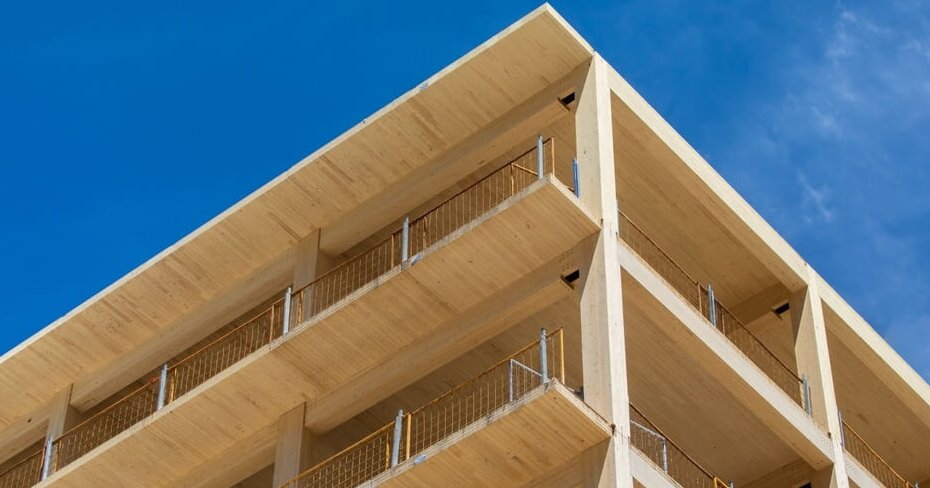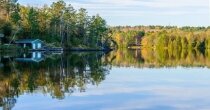What is mass timber construction, and how is it insured?
By: Steven Brennan on April 23, 2024
For several years now Canada has been at the forefront of a revolution in building and construction, which could help efforts to reduce carbon emissions, increase new housing, as well as improve the look and feel of our cities and communities.
In recent weeks, politicians in both British Columbia and Ontario made moves to allow for more development of mass timber construction (MTC) projects. But while the design and construction industries seem ready to lead the way, there are still some kinks to work out before mass timber really takes root in Canada.
At a glance:
The basics of mass timber construction
‘Mass timber’ refers to a family of engineered wood components that can be used in place of steel, concrete or light-frame timber constructions. Some of the most common types of mass timber used for construction today include cross-laminated timber (CLT), dowel-laminated timber (DLT) and nail-laminated timber (NLT).
As the names suggest, these materials are all made by securing multiple layers of wood together through various methods, increasing their strength and durability.
MTC is considered to be durable, cost-effective and carbon neutral. In addition, these builds are also often considered comparatively more beneficial to our health and wellbeing.
For these and other reasons, mass timber construction has been growing across Canada, particularly in Ontario and British Columbia where there’s more access to sustainable timber.
Even though the term might be new, many of us are already familiar with mass timber designs. UBC’s Brock Commons Tallwood House, the Richmond Olympic Oval and Toronto’s T3 Sterling Road are some of Canada’s finest examples of innovative MTC and design to-date.
Related read: One third of homeowners worried about extreme weather damage
Mass timber growth in Canada
For well over a decade, MTC has grown to become a stand-out choice for many new builds throughout the country. According to the State of Mass Timber database, Canada has already 689 completed mass timber buildings since 2007, with a further 143 planned or under construction. These builds include commercial and residential projects, community centers, public libraries, firehouses and more.
The technological development of mass timber design has made it increasingly feasible and cost-effective to build larger and more complex structures in this way, with architects and developers alike embracing its versatility and aesthetic appeal.
Builders are increasingly turning to MTC to achieve faster and lower-carbon construction projects, with the help of prefabricated structures and materials that can be delivered from within Canada right before they’re needed on site. And because mass timber is sourced from renewable and managed forests, it offers a genuinely sustainable and low-emission option compared to concrete and steel construction (cement manufacturing is one of the largest sources of greenhouse grass emissions on the planet).
Canada is at the forefront of the global mass timber industry, which has been forecast to grow over 14% CAGR through 2029. And Canada’s building codes are slowly changing to accommodate taller mass timber builds, which could potentially help address the long-standing housing crisis, as well as create more environmentally-friendly cities. However, for all the positives there are still some growing pains for the mass timber industry to overcome.
Risks of mass timber construction
While experts within the construction and design industries may be intimately familiar with the benefits of MTC, it seems there are still educational gaps for the industry to bridge when it comes to stakeholders, investors and developers. Fire and water risks have and continue to pose a big question mark around the economic feasibility of these builds, especially in relation to high-rise commercial and residential construction.
However, recent tests led by the Canadian Wood Council have demonstrated that mass timber’s fire risks could be overstated. These have been the most extensive fire tests on mass timber to-date, with impressive results showing its ability to meet or even exceed current building code standards. “There is a misconception that [mass] timber is vulnerable to fire”, according to an Insuring Mass Timber report from 2021.
Those misconceptions do not apply to the insurance industry, however, which perhaps poses the greatest challenge to mass timber's attempts at going mainstream.
How is mass timber insured?
According to the Pacific Northwest Building Resilience Coalition, insurance costs for Canadian MTC projects are estimated to range from five to seven times higher than comparable steel builds. Both occupancy and builder’s risk insurance premiums are higher, and their terms are often more complex. From the perspective of insurance companies, the reason is simple: There is almost no history of claims to work from.
Because insurers have limited data to go on, they’ve got little appetite to find out exactly how those mass timber fire tests will translate into a real-world claim. And there’s also the question of water damage, as well as earthquake resilience.
“As with anything new, it takes time to see how it performs”, says Daniel Mirkovic, President & CEO of Square One Insurance in Vancouver, BC.
Many brokers choose to limit their involvement with MTC builds, primarily because they represent such a huge unknown. This combination of high premiums and a lack of willing providers means that mass timber developers often have to use multiple insurers to underwrite their construction, spreading the total risk across several insurers.
Related: How do insurance companies make money?
With builders and developers forking out higher premiums for these innovative builds, homeowners might be concerned about the potential downstream costs through condo and property fees.
“The price people pay to buy or rent homes reflects the original construction costs,” says Mirkovic. “It’s a bit premature to know whether higher condo or property fees are associated with mass timber buildings. The fees are dependent on maintenance and operating costs, which includes commercial building insurance.”
While home insurance brokers may be hesitant to directly associate mass timber constructions with higher premiums for consumers, Mirkovic does note that insurance rates will vary depending on the construction type of your building.
“Ultimately, consumers should be prepared that there may be greater fluctuations in prices for mass timber high-rises,” he says.
Building a new frontier
There’s little doubt that MTC presents promising solutions for Canada's housing and environmental challenges, but the path to widespread adoption faces hurdles such as insurance complexities and lingering concerns around safety.
Mass timber construction is not exactly new, but in the eyes of underwriters these builds clearly represent uncharted territory. As Canada leads the way forward in this innovative, sustainable, and pioneering design and construction industry, it seems that only time will tell us just how far (and high) mass timber can grow.
Save 20% on average on home insurance
Compare quotes from 50+ Canadian providers in 3 minutes.


